Assessing Virgin Atlantic's Disruption Policy Using Key Frameworks
VerifiedAdded on 2023/06/15
|10
|2627
|357
Essay
AI Summary
This essay provides an analysis of Virgin Atlantic's flight disruption policy, examining its effectiveness in enhancing the airline's attractiveness and competitiveness. The analysis utilizes frameworks such as Ritchie and Crouch's model, Porter's Five Forces, and the Ansoff Matrix to evaluate the policy's impact on customer loyalty, market value, and overall business sustainability. The essay highlights instances where the policy has fallen short, such as the London-Gatwick flight delay in 2015, and emphasizes the importance of effective management, innovative technologies, and strategic capabilities in ensuring the policy's success. It also considers the influence of external factors like Brexit and EU regulations on the policy's effectiveness. The essay concludes that while the disruption policy has the potential to benefit Virgin Atlantic, its success hinges on robust implementation, continuous improvement, and a proactive approach to addressing customer needs and competitive pressures. Desklib offers a wide range of past papers and solved assignments to support students in their academic endeavors.
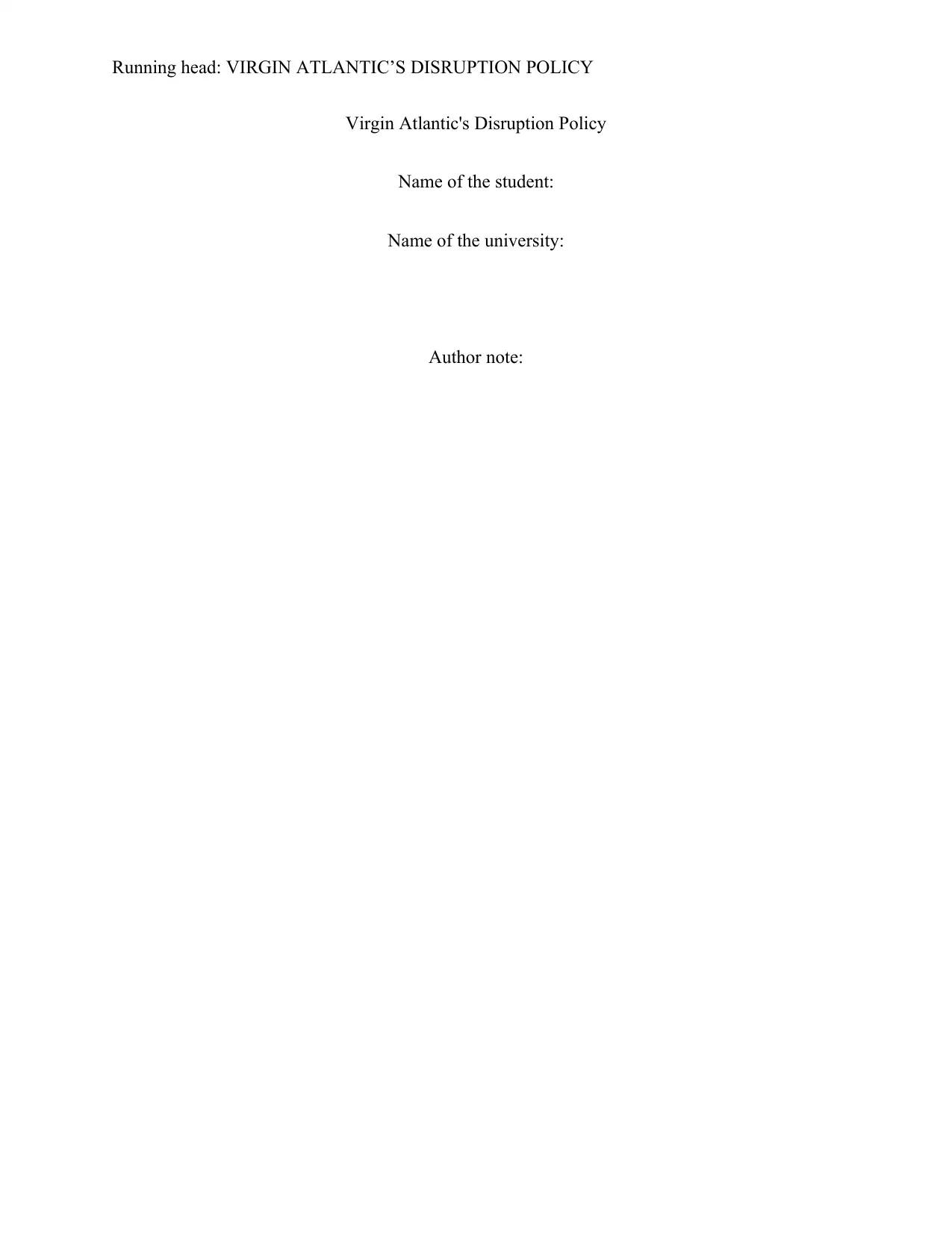
Running head: VIRGIN ATLANTIC’S DISRUPTION POLICY
Virgin Atlantic's Disruption Policy
Name of the student:
Name of the university:
Author note:
Virgin Atlantic's Disruption Policy
Name of the student:
Name of the university:
Author note:
Paraphrase This Document
Need a fresh take? Get an instant paraphrase of this document with our AI Paraphraser
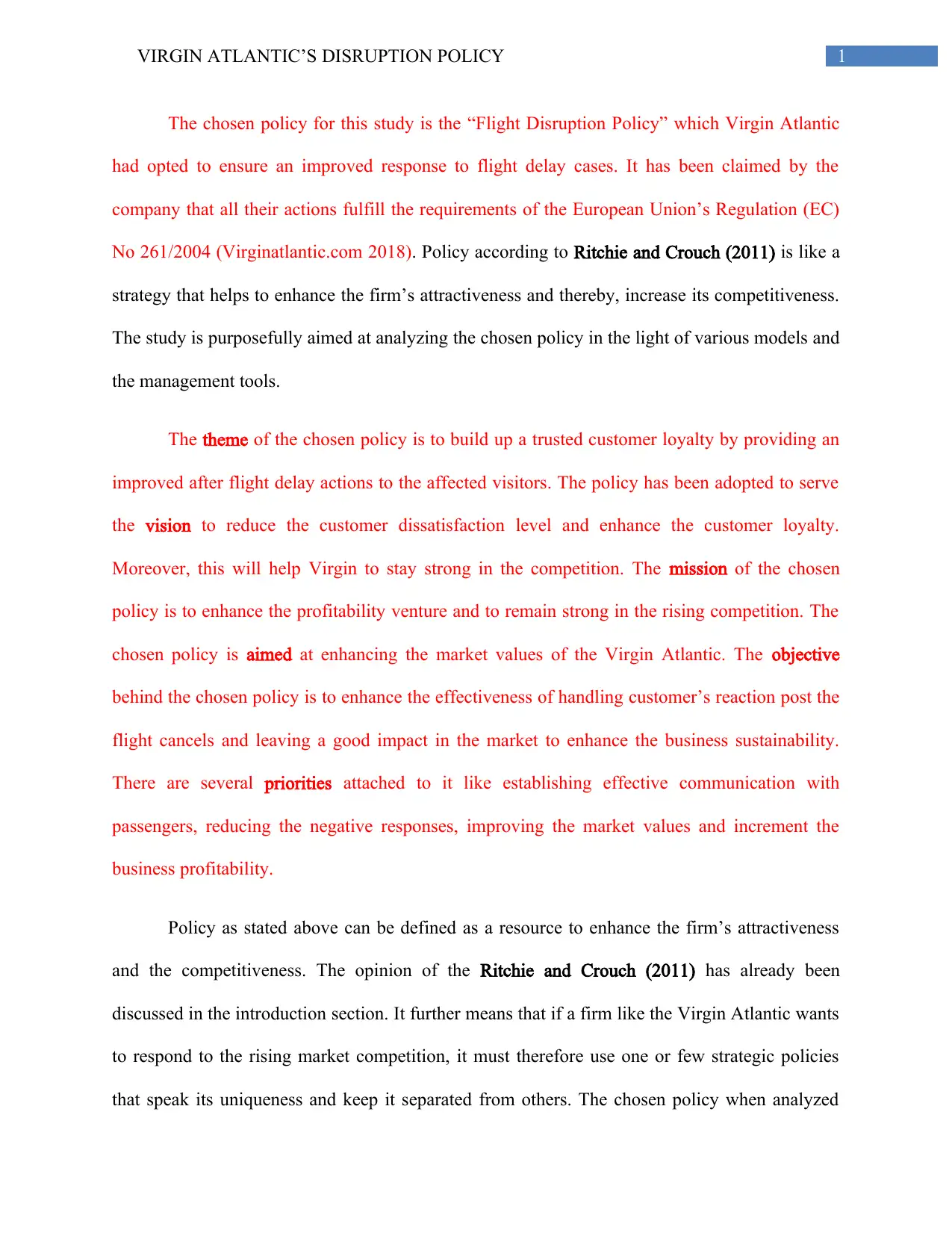
1VIRGIN ATLANTIC’S DISRUPTION POLICY
The chosen policy for this study is the “Flight Disruption Policy” which Virgin Atlantic
had opted to ensure an improved response to flight delay cases. It has been claimed by the
company that all their actions fulfill the requirements of the European Union’s Regulation (EC)
No 261/2004 (Virginatlantic.com 2018). Policy according to Ritchie and Crouch (2011) is like a
strategy that helps to enhance the firm’s attractiveness and thereby, increase its competitiveness.
The study is purposefully aimed at analyzing the chosen policy in the light of various models and
the management tools.
The theme of the chosen policy is to build up a trusted customer loyalty by providing an
improved after flight delay actions to the affected visitors. The policy has been adopted to serve
the vision to reduce the customer dissatisfaction level and enhance the customer loyalty.
Moreover, this will help Virgin to stay strong in the competition. The mission of the chosen
policy is to enhance the profitability venture and to remain strong in the rising competition. The
chosen policy is aimed at enhancing the market values of the Virgin Atlantic. The objective
behind the chosen policy is to enhance the effectiveness of handling customer’s reaction post the
flight cancels and leaving a good impact in the market to enhance the business sustainability.
There are several priorities attached to it like establishing effective communication with
passengers, reducing the negative responses, improving the market values and increment the
business profitability.
Policy as stated above can be defined as a resource to enhance the firm’s attractiveness
and the competitiveness. The opinion of the Ritchie and Crouch (2011) has already been
discussed in the introduction section. It further means that if a firm like the Virgin Atlantic wants
to respond to the rising market competition, it must therefore use one or few strategic policies
that speak its uniqueness and keep it separated from others. The chosen policy when analyzed
The chosen policy for this study is the “Flight Disruption Policy” which Virgin Atlantic
had opted to ensure an improved response to flight delay cases. It has been claimed by the
company that all their actions fulfill the requirements of the European Union’s Regulation (EC)
No 261/2004 (Virginatlantic.com 2018). Policy according to Ritchie and Crouch (2011) is like a
strategy that helps to enhance the firm’s attractiveness and thereby, increase its competitiveness.
The study is purposefully aimed at analyzing the chosen policy in the light of various models and
the management tools.
The theme of the chosen policy is to build up a trusted customer loyalty by providing an
improved after flight delay actions to the affected visitors. The policy has been adopted to serve
the vision to reduce the customer dissatisfaction level and enhance the customer loyalty.
Moreover, this will help Virgin to stay strong in the competition. The mission of the chosen
policy is to enhance the profitability venture and to remain strong in the rising competition. The
chosen policy is aimed at enhancing the market values of the Virgin Atlantic. The objective
behind the chosen policy is to enhance the effectiveness of handling customer’s reaction post the
flight cancels and leaving a good impact in the market to enhance the business sustainability.
There are several priorities attached to it like establishing effective communication with
passengers, reducing the negative responses, improving the market values and increment the
business profitability.
Policy as stated above can be defined as a resource to enhance the firm’s attractiveness
and the competitiveness. The opinion of the Ritchie and Crouch (2011) has already been
discussed in the introduction section. It further means that if a firm like the Virgin Atlantic wants
to respond to the rising market competition, it must therefore use one or few strategic policies
that speak its uniqueness and keep it separated from others. The chosen policy when analyzed
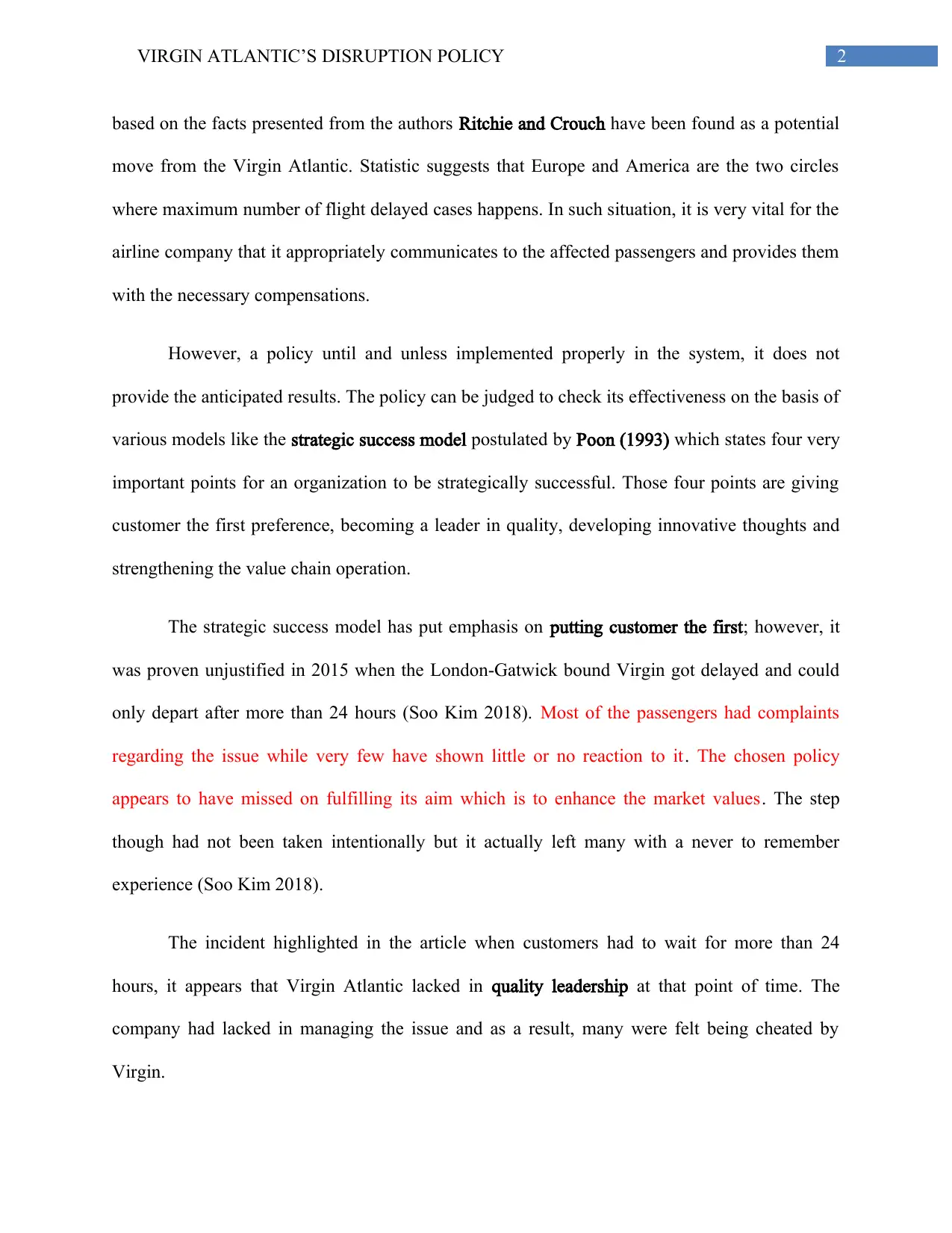
2VIRGIN ATLANTIC’S DISRUPTION POLICY
based on the facts presented from the authors Ritchie and Crouch have been found as a potential
move from the Virgin Atlantic. Statistic suggests that Europe and America are the two circles
where maximum number of flight delayed cases happens. In such situation, it is very vital for the
airline company that it appropriately communicates to the affected passengers and provides them
with the necessary compensations.
However, a policy until and unless implemented properly in the system, it does not
provide the anticipated results. The policy can be judged to check its effectiveness on the basis of
various models like the strategic success model postulated by Poon (1993) which states four very
important points for an organization to be strategically successful. Those four points are giving
customer the first preference, becoming a leader in quality, developing innovative thoughts and
strengthening the value chain operation.
The strategic success model has put emphasis on putting customer the first; however, it
was proven unjustified in 2015 when the London-Gatwick bound Virgin got delayed and could
only depart after more than 24 hours (Soo Kim 2018). Most of the passengers had complaints
regarding the issue while very few have shown little or no reaction to it. The chosen policy
appears to have missed on fulfilling its aim which is to enhance the market values. The step
though had not been taken intentionally but it actually left many with a never to remember
experience (Soo Kim 2018).
The incident highlighted in the article when customers had to wait for more than 24
hours, it appears that Virgin Atlantic lacked in quality leadership at that point of time. The
company had lacked in managing the issue and as a result, many were felt being cheated by
Virgin.
based on the facts presented from the authors Ritchie and Crouch have been found as a potential
move from the Virgin Atlantic. Statistic suggests that Europe and America are the two circles
where maximum number of flight delayed cases happens. In such situation, it is very vital for the
airline company that it appropriately communicates to the affected passengers and provides them
with the necessary compensations.
However, a policy until and unless implemented properly in the system, it does not
provide the anticipated results. The policy can be judged to check its effectiveness on the basis of
various models like the strategic success model postulated by Poon (1993) which states four very
important points for an organization to be strategically successful. Those four points are giving
customer the first preference, becoming a leader in quality, developing innovative thoughts and
strengthening the value chain operation.
The strategic success model has put emphasis on putting customer the first; however, it
was proven unjustified in 2015 when the London-Gatwick bound Virgin got delayed and could
only depart after more than 24 hours (Soo Kim 2018). Most of the passengers had complaints
regarding the issue while very few have shown little or no reaction to it. The chosen policy
appears to have missed on fulfilling its aim which is to enhance the market values. The step
though had not been taken intentionally but it actually left many with a never to remember
experience (Soo Kim 2018).
The incident highlighted in the article when customers had to wait for more than 24
hours, it appears that Virgin Atlantic lacked in quality leadership at that point of time. The
company had lacked in managing the issue and as a result, many were felt being cheated by
Virgin.
⊘ This is a preview!⊘
Do you want full access?
Subscribe today to unlock all pages.

Trusted by 1+ million students worldwide
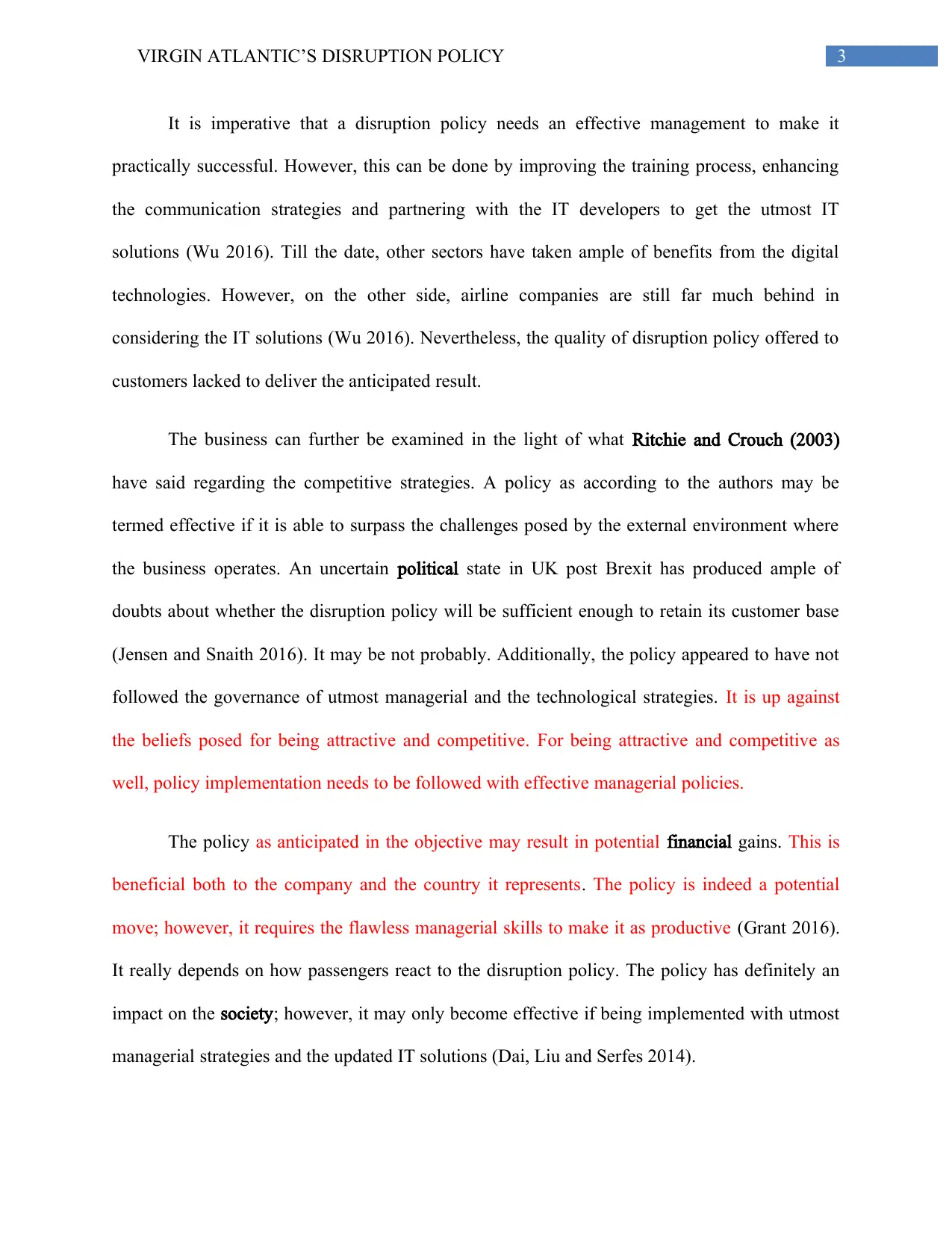
3VIRGIN ATLANTIC’S DISRUPTION POLICY
It is imperative that a disruption policy needs an effective management to make it
practically successful. However, this can be done by improving the training process, enhancing
the communication strategies and partnering with the IT developers to get the utmost IT
solutions (Wu 2016). Till the date, other sectors have taken ample of benefits from the digital
technologies. However, on the other side, airline companies are still far much behind in
considering the IT solutions (Wu 2016). Nevertheless, the quality of disruption policy offered to
customers lacked to deliver the anticipated result.
The business can further be examined in the light of what Ritchie and Crouch (2003)
have said regarding the competitive strategies. A policy as according to the authors may be
termed effective if it is able to surpass the challenges posed by the external environment where
the business operates. An uncertain political state in UK post Brexit has produced ample of
doubts about whether the disruption policy will be sufficient enough to retain its customer base
(Jensen and Snaith 2016). It may be not probably. Additionally, the policy appeared to have not
followed the governance of utmost managerial and the technological strategies. It is up against
the beliefs posed for being attractive and competitive. For being attractive and competitive as
well, policy implementation needs to be followed with effective managerial policies.
The policy as anticipated in the objective may result in potential financial gains. This is
beneficial both to the company and the country it represents. The policy is indeed a potential
move; however, it requires the flawless managerial skills to make it as productive (Grant 2016).
It really depends on how passengers react to the disruption policy. The policy has definitely an
impact on the society; however, it may only become effective if being implemented with utmost
managerial strategies and the updated IT solutions (Dai, Liu and Serfes 2014).
It is imperative that a disruption policy needs an effective management to make it
practically successful. However, this can be done by improving the training process, enhancing
the communication strategies and partnering with the IT developers to get the utmost IT
solutions (Wu 2016). Till the date, other sectors have taken ample of benefits from the digital
technologies. However, on the other side, airline companies are still far much behind in
considering the IT solutions (Wu 2016). Nevertheless, the quality of disruption policy offered to
customers lacked to deliver the anticipated result.
The business can further be examined in the light of what Ritchie and Crouch (2003)
have said regarding the competitive strategies. A policy as according to the authors may be
termed effective if it is able to surpass the challenges posed by the external environment where
the business operates. An uncertain political state in UK post Brexit has produced ample of
doubts about whether the disruption policy will be sufficient enough to retain its customer base
(Jensen and Snaith 2016). It may be not probably. Additionally, the policy appeared to have not
followed the governance of utmost managerial and the technological strategies. It is up against
the beliefs posed for being attractive and competitive. For being attractive and competitive as
well, policy implementation needs to be followed with effective managerial policies.
The policy as anticipated in the objective may result in potential financial gains. This is
beneficial both to the company and the country it represents. The policy is indeed a potential
move; however, it requires the flawless managerial skills to make it as productive (Grant 2016).
It really depends on how passengers react to the disruption policy. The policy has definitely an
impact on the society; however, it may only become effective if being implemented with utmost
managerial strategies and the updated IT solutions (Dai, Liu and Serfes 2014).
Paraphrase This Document
Need a fresh take? Get an instant paraphrase of this document with our AI Paraphraser
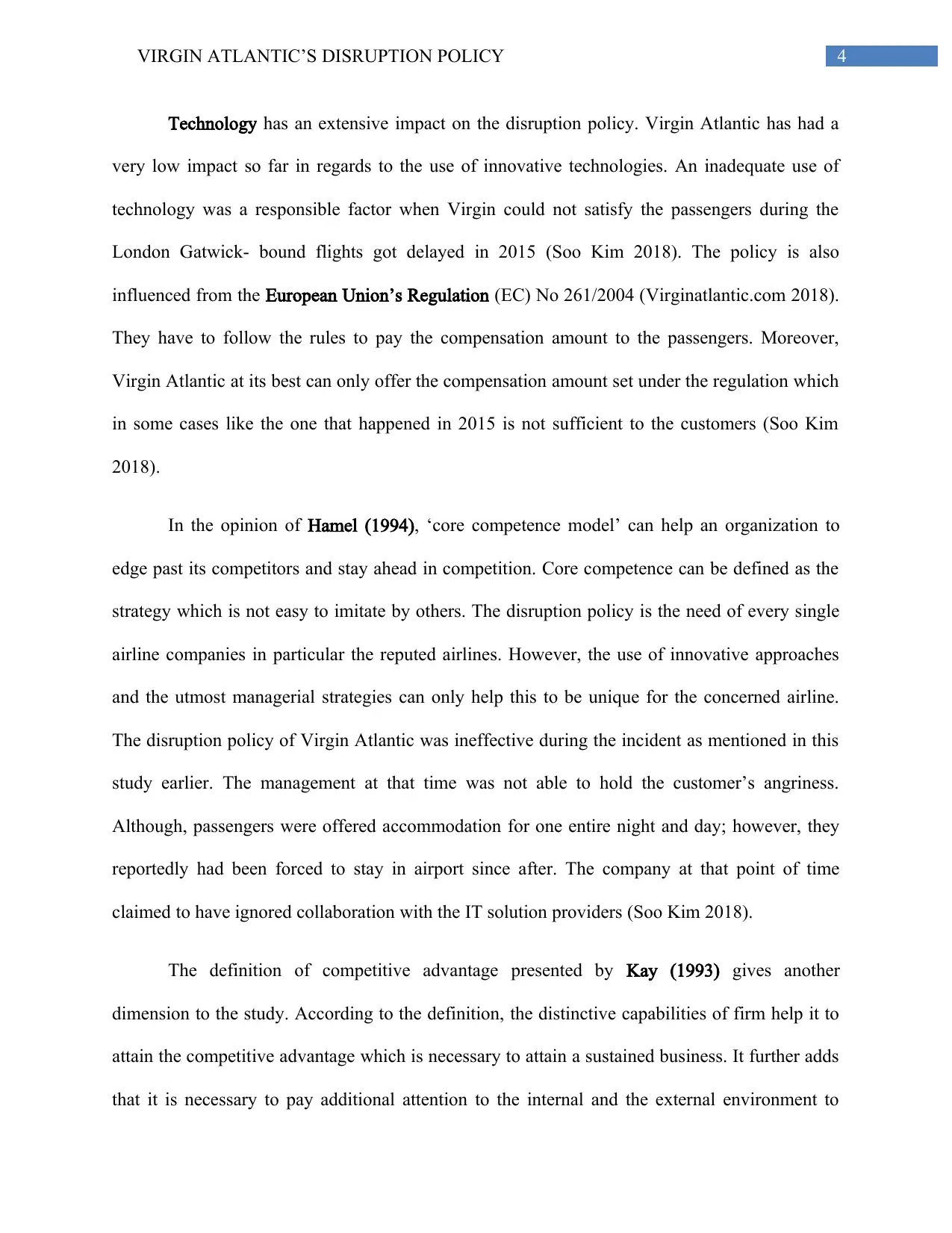
4VIRGIN ATLANTIC’S DISRUPTION POLICY
Technology has an extensive impact on the disruption policy. Virgin Atlantic has had a
very low impact so far in regards to the use of innovative technologies. An inadequate use of
technology was a responsible factor when Virgin could not satisfy the passengers during the
London Gatwick- bound flights got delayed in 2015 (Soo Kim 2018). The policy is also
influenced from the European Union’s Regulation (EC) No 261/2004 (Virginatlantic.com 2018).
They have to follow the rules to pay the compensation amount to the passengers. Moreover,
Virgin Atlantic at its best can only offer the compensation amount set under the regulation which
in some cases like the one that happened in 2015 is not sufficient to the customers (Soo Kim
2018).
In the opinion of Hamel (1994), ‘core competence model’ can help an organization to
edge past its competitors and stay ahead in competition. Core competence can be defined as the
strategy which is not easy to imitate by others. The disruption policy is the need of every single
airline companies in particular the reputed airlines. However, the use of innovative approaches
and the utmost managerial strategies can only help this to be unique for the concerned airline.
The disruption policy of Virgin Atlantic was ineffective during the incident as mentioned in this
study earlier. The management at that time was not able to hold the customer’s angriness.
Although, passengers were offered accommodation for one entire night and day; however, they
reportedly had been forced to stay in airport since after. The company at that point of time
claimed to have ignored collaboration with the IT solution providers (Soo Kim 2018).
The definition of competitive advantage presented by Kay (1993) gives another
dimension to the study. According to the definition, the distinctive capabilities of firm help it to
attain the competitive advantage which is necessary to attain a sustained business. It further adds
that it is necessary to pay additional attention to the internal and the external environment to
Technology has an extensive impact on the disruption policy. Virgin Atlantic has had a
very low impact so far in regards to the use of innovative technologies. An inadequate use of
technology was a responsible factor when Virgin could not satisfy the passengers during the
London Gatwick- bound flights got delayed in 2015 (Soo Kim 2018). The policy is also
influenced from the European Union’s Regulation (EC) No 261/2004 (Virginatlantic.com 2018).
They have to follow the rules to pay the compensation amount to the passengers. Moreover,
Virgin Atlantic at its best can only offer the compensation amount set under the regulation which
in some cases like the one that happened in 2015 is not sufficient to the customers (Soo Kim
2018).
In the opinion of Hamel (1994), ‘core competence model’ can help an organization to
edge past its competitors and stay ahead in competition. Core competence can be defined as the
strategy which is not easy to imitate by others. The disruption policy is the need of every single
airline companies in particular the reputed airlines. However, the use of innovative approaches
and the utmost managerial strategies can only help this to be unique for the concerned airline.
The disruption policy of Virgin Atlantic was ineffective during the incident as mentioned in this
study earlier. The management at that time was not able to hold the customer’s angriness.
Although, passengers were offered accommodation for one entire night and day; however, they
reportedly had been forced to stay in airport since after. The company at that point of time
claimed to have ignored collaboration with the IT solution providers (Soo Kim 2018).
The definition of competitive advantage presented by Kay (1993) gives another
dimension to the study. According to the definition, the distinctive capabilities of firm help it to
attain the competitive advantage which is necessary to attain a sustained business. It further adds
that it is necessary to pay additional attention to the internal and the external environment to
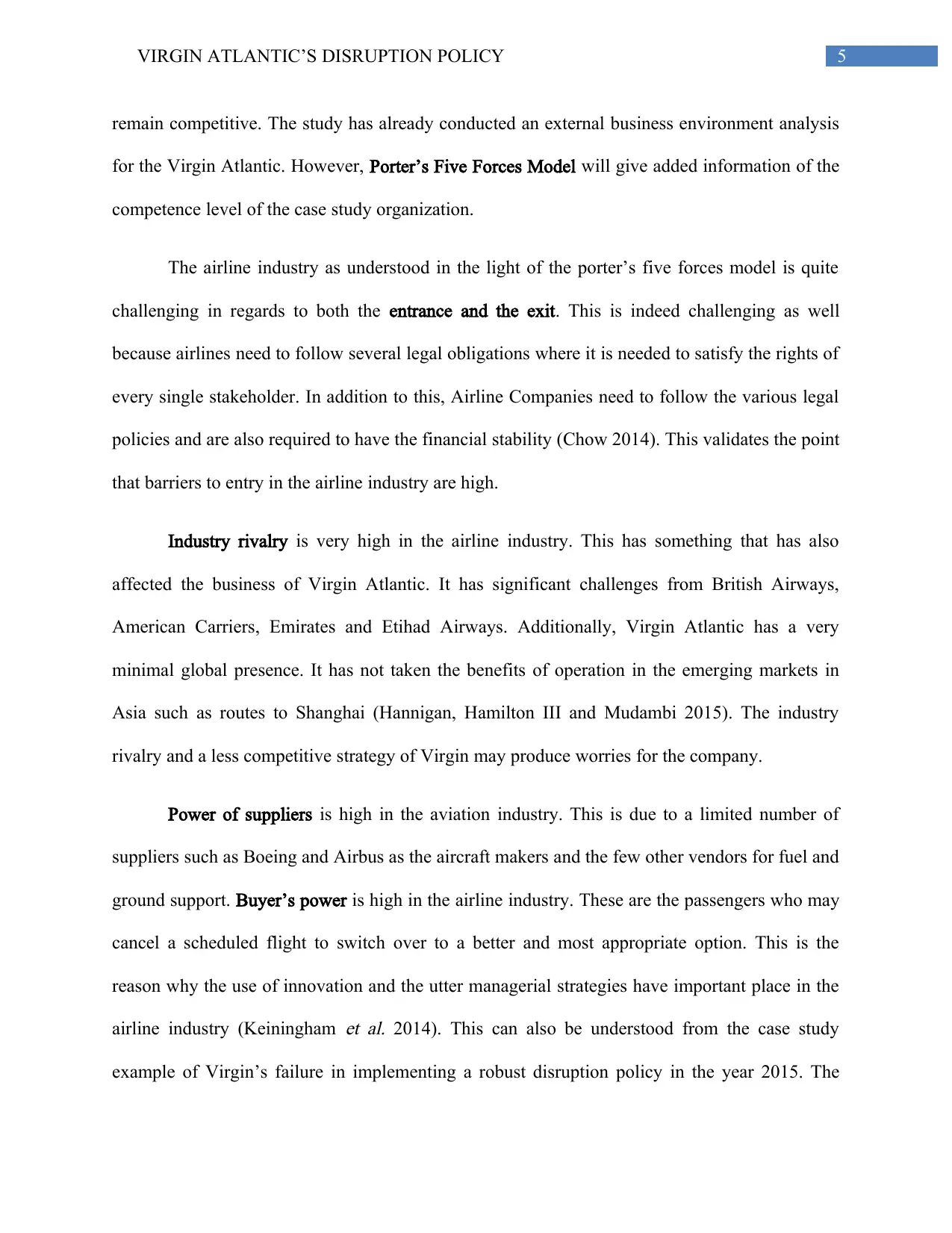
5VIRGIN ATLANTIC’S DISRUPTION POLICY
remain competitive. The study has already conducted an external business environment analysis
for the Virgin Atlantic. However, Porter’s Five Forces Model will give added information of the
competence level of the case study organization.
The airline industry as understood in the light of the porter’s five forces model is quite
challenging in regards to both the entrance and the exit. This is indeed challenging as well
because airlines need to follow several legal obligations where it is needed to satisfy the rights of
every single stakeholder. In addition to this, Airline Companies need to follow the various legal
policies and are also required to have the financial stability (Chow 2014). This validates the point
that barriers to entry in the airline industry are high.
Industry rivalry is very high in the airline industry. This has something that has also
affected the business of Virgin Atlantic. It has significant challenges from British Airways,
American Carriers, Emirates and Etihad Airways. Additionally, Virgin Atlantic has a very
minimal global presence. It has not taken the benefits of operation in the emerging markets in
Asia such as routes to Shanghai (Hannigan, Hamilton III and Mudambi 2015). The industry
rivalry and a less competitive strategy of Virgin may produce worries for the company.
Power of suppliers is high in the aviation industry. This is due to a limited number of
suppliers such as Boeing and Airbus as the aircraft makers and the few other vendors for fuel and
ground support. Buyer’s power is high in the airline industry. These are the passengers who may
cancel a scheduled flight to switch over to a better and most appropriate option. This is the
reason why the use of innovation and the utter managerial strategies have important place in the
airline industry (Keiningham
et al. 2014). This can also be understood from the case study
example of Virgin’s failure in implementing a robust disruption policy in the year 2015. The
remain competitive. The study has already conducted an external business environment analysis
for the Virgin Atlantic. However, Porter’s Five Forces Model will give added information of the
competence level of the case study organization.
The airline industry as understood in the light of the porter’s five forces model is quite
challenging in regards to both the entrance and the exit. This is indeed challenging as well
because airlines need to follow several legal obligations where it is needed to satisfy the rights of
every single stakeholder. In addition to this, Airline Companies need to follow the various legal
policies and are also required to have the financial stability (Chow 2014). This validates the point
that barriers to entry in the airline industry are high.
Industry rivalry is very high in the airline industry. This has something that has also
affected the business of Virgin Atlantic. It has significant challenges from British Airways,
American Carriers, Emirates and Etihad Airways. Additionally, Virgin Atlantic has a very
minimal global presence. It has not taken the benefits of operation in the emerging markets in
Asia such as routes to Shanghai (Hannigan, Hamilton III and Mudambi 2015). The industry
rivalry and a less competitive strategy of Virgin may produce worries for the company.
Power of suppliers is high in the aviation industry. This is due to a limited number of
suppliers such as Boeing and Airbus as the aircraft makers and the few other vendors for fuel and
ground support. Buyer’s power is high in the airline industry. These are the passengers who may
cancel a scheduled flight to switch over to a better and most appropriate option. This is the
reason why the use of innovation and the utter managerial strategies have important place in the
airline industry (Keiningham
et al. 2014). This can also be understood from the case study
example of Virgin’s failure in implementing a robust disruption policy in the year 2015. The
⊘ This is a preview!⊘
Do you want full access?
Subscribe today to unlock all pages.

Trusted by 1+ million students worldwide
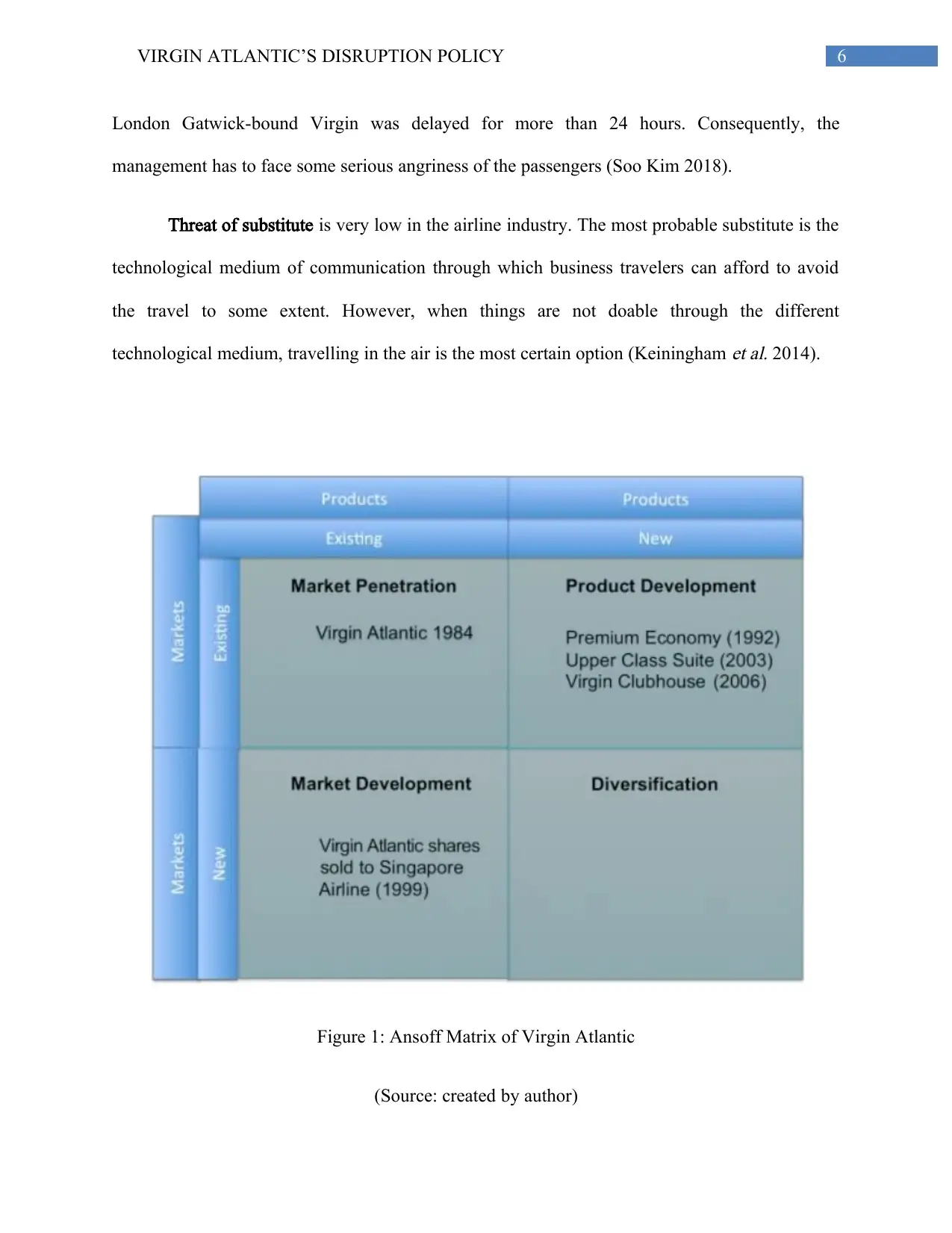
6VIRGIN ATLANTIC’S DISRUPTION POLICY
London Gatwick-bound Virgin was delayed for more than 24 hours. Consequently, the
management has to face some serious angriness of the passengers (Soo Kim 2018).
Threat of substitute is very low in the airline industry. The most probable substitute is the
technological medium of communication through which business travelers can afford to avoid
the travel to some extent. However, when things are not doable through the different
technological medium, travelling in the air is the most certain option (Keiningham
et al. 2014).
Figure 1: Ansoff Matrix of Virgin Atlantic
(Source: created by author)
London Gatwick-bound Virgin was delayed for more than 24 hours. Consequently, the
management has to face some serious angriness of the passengers (Soo Kim 2018).
Threat of substitute is very low in the airline industry. The most probable substitute is the
technological medium of communication through which business travelers can afford to avoid
the travel to some extent. However, when things are not doable through the different
technological medium, travelling in the air is the most certain option (Keiningham
et al. 2014).
Figure 1: Ansoff Matrix of Virgin Atlantic
(Source: created by author)
Paraphrase This Document
Need a fresh take? Get an instant paraphrase of this document with our AI Paraphraser
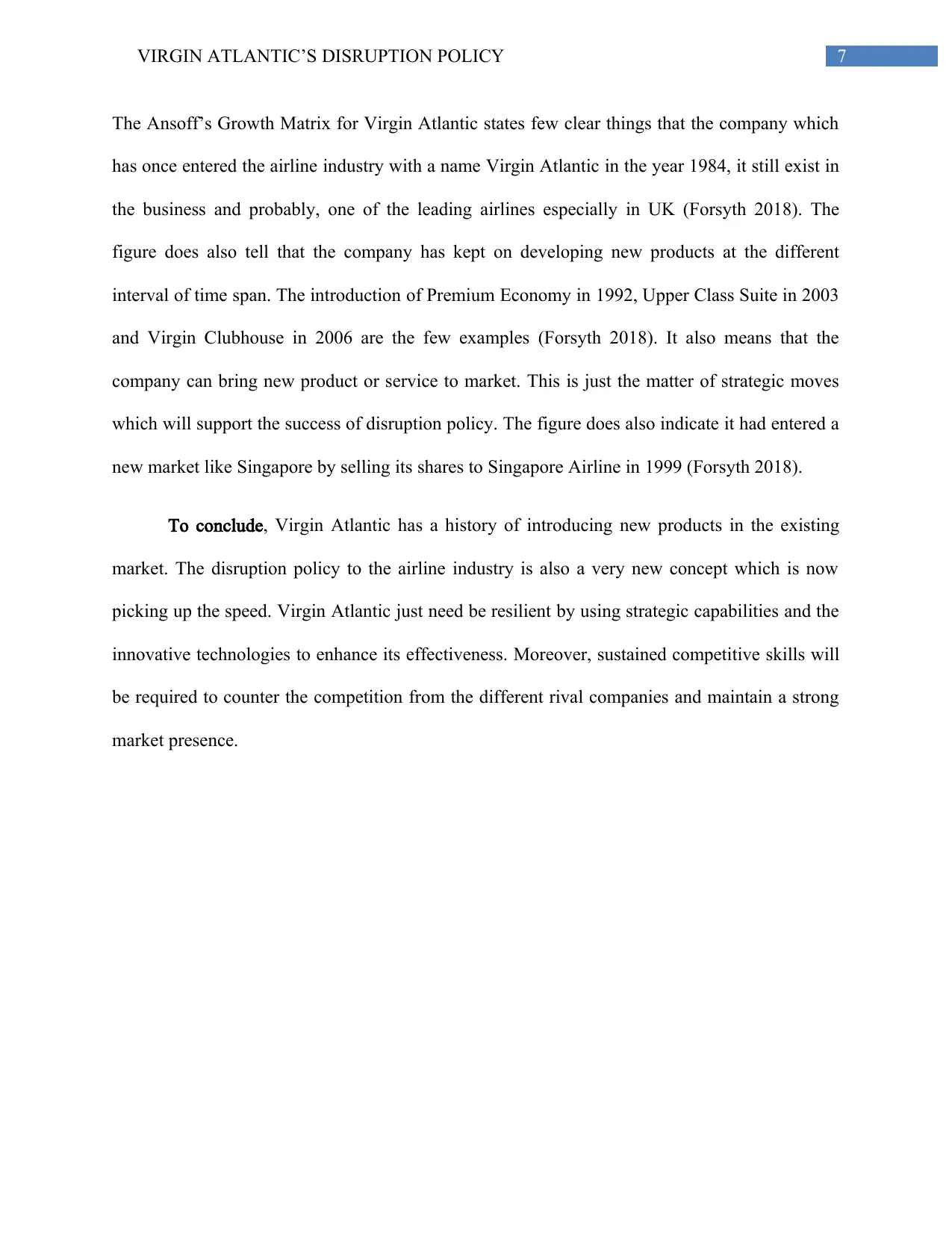
7VIRGIN ATLANTIC’S DISRUPTION POLICY
The Ansoff’s Growth Matrix for Virgin Atlantic states few clear things that the company which
has once entered the airline industry with a name Virgin Atlantic in the year 1984, it still exist in
the business and probably, one of the leading airlines especially in UK (Forsyth 2018). The
figure does also tell that the company has kept on developing new products at the different
interval of time span. The introduction of Premium Economy in 1992, Upper Class Suite in 2003
and Virgin Clubhouse in 2006 are the few examples (Forsyth 2018). It also means that the
company can bring new product or service to market. This is just the matter of strategic moves
which will support the success of disruption policy. The figure does also indicate it had entered a
new market like Singapore by selling its shares to Singapore Airline in 1999 (Forsyth 2018).
To conclude, Virgin Atlantic has a history of introducing new products in the existing
market. The disruption policy to the airline industry is also a very new concept which is now
picking up the speed. Virgin Atlantic just need be resilient by using strategic capabilities and the
innovative technologies to enhance its effectiveness. Moreover, sustained competitive skills will
be required to counter the competition from the different rival companies and maintain a strong
market presence.
The Ansoff’s Growth Matrix for Virgin Atlantic states few clear things that the company which
has once entered the airline industry with a name Virgin Atlantic in the year 1984, it still exist in
the business and probably, one of the leading airlines especially in UK (Forsyth 2018). The
figure does also tell that the company has kept on developing new products at the different
interval of time span. The introduction of Premium Economy in 1992, Upper Class Suite in 2003
and Virgin Clubhouse in 2006 are the few examples (Forsyth 2018). It also means that the
company can bring new product or service to market. This is just the matter of strategic moves
which will support the success of disruption policy. The figure does also indicate it had entered a
new market like Singapore by selling its shares to Singapore Airline in 1999 (Forsyth 2018).
To conclude, Virgin Atlantic has a history of introducing new products in the existing
market. The disruption policy to the airline industry is also a very new concept which is now
picking up the speed. Virgin Atlantic just need be resilient by using strategic capabilities and the
innovative technologies to enhance its effectiveness. Moreover, sustained competitive skills will
be required to counter the competition from the different rival companies and maintain a strong
market presence.
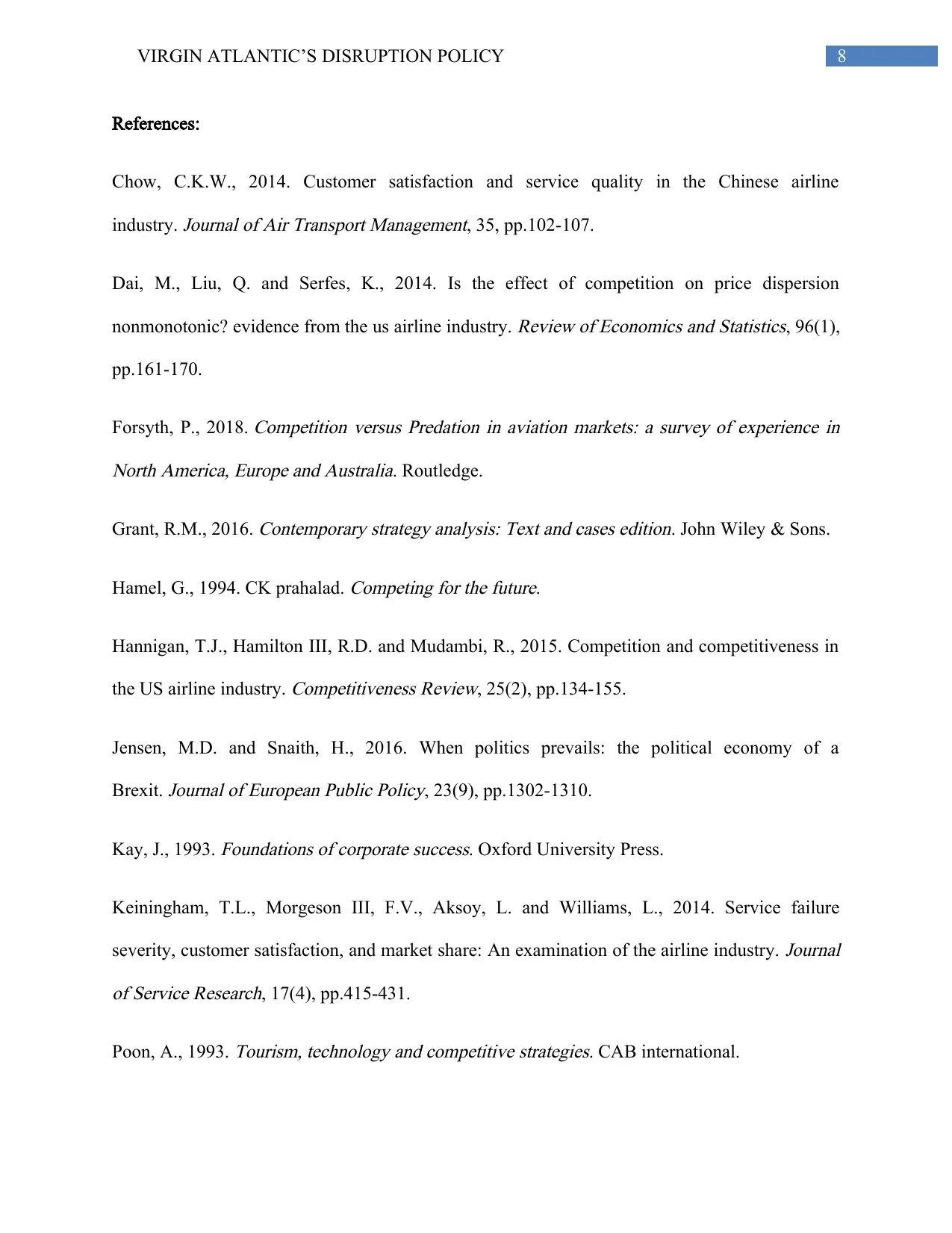
8VIRGIN ATLANTIC’S DISRUPTION POLICY
References:
Chow, C.K.W., 2014. Customer satisfaction and service quality in the Chinese airline
industry.
Journal of Air Transport Management, 35, pp.102-107.
Dai, M., Liu, Q. and Serfes, K., 2014. Is the effect of competition on price dispersion
nonmonotonic? evidence from the us airline industry.
Review of Economics and Statistics, 96(1),
pp.161-170.
Forsyth, P., 2018.
Competition versus Predation in aviation markets: a survey of experience in
North America, Europe and Australia. Routledge.
Grant, R.M., 2016.
Contemporary strategy analysis: Text and cases edition. John Wiley & Sons.
Hamel, G., 1994. CK prahalad.
Competing for the future.
Hannigan, T.J., Hamilton III, R.D. and Mudambi, R., 2015. Competition and competitiveness in
the US airline industry.
Competitiveness Review, 25(2), pp.134-155.
Jensen, M.D. and Snaith, H., 2016. When politics prevails: the political economy of a
Brexit.
Journal of European Public Policy, 23(9), pp.1302-1310.
Kay, J., 1993.
Foundations of corporate success. Oxford University Press.
Keiningham, T.L., Morgeson III, F.V., Aksoy, L. and Williams, L., 2014. Service failure
severity, customer satisfaction, and market share: An examination of the airline industry.
Journal
of Service Research, 17(4), pp.415-431.
Poon, A., 1993.
Tourism, technology and competitive strategies. CAB international.
References:
Chow, C.K.W., 2014. Customer satisfaction and service quality in the Chinese airline
industry.
Journal of Air Transport Management, 35, pp.102-107.
Dai, M., Liu, Q. and Serfes, K., 2014. Is the effect of competition on price dispersion
nonmonotonic? evidence from the us airline industry.
Review of Economics and Statistics, 96(1),
pp.161-170.
Forsyth, P., 2018.
Competition versus Predation in aviation markets: a survey of experience in
North America, Europe and Australia. Routledge.
Grant, R.M., 2016.
Contemporary strategy analysis: Text and cases edition. John Wiley & Sons.
Hamel, G., 1994. CK prahalad.
Competing for the future.
Hannigan, T.J., Hamilton III, R.D. and Mudambi, R., 2015. Competition and competitiveness in
the US airline industry.
Competitiveness Review, 25(2), pp.134-155.
Jensen, M.D. and Snaith, H., 2016. When politics prevails: the political economy of a
Brexit.
Journal of European Public Policy, 23(9), pp.1302-1310.
Kay, J., 1993.
Foundations of corporate success. Oxford University Press.
Keiningham, T.L., Morgeson III, F.V., Aksoy, L. and Williams, L., 2014. Service failure
severity, customer satisfaction, and market share: An examination of the airline industry.
Journal
of Service Research, 17(4), pp.415-431.
Poon, A., 1993.
Tourism, technology and competitive strategies. CAB international.
⊘ This is a preview!⊘
Do you want full access?
Subscribe today to unlock all pages.

Trusted by 1+ million students worldwide
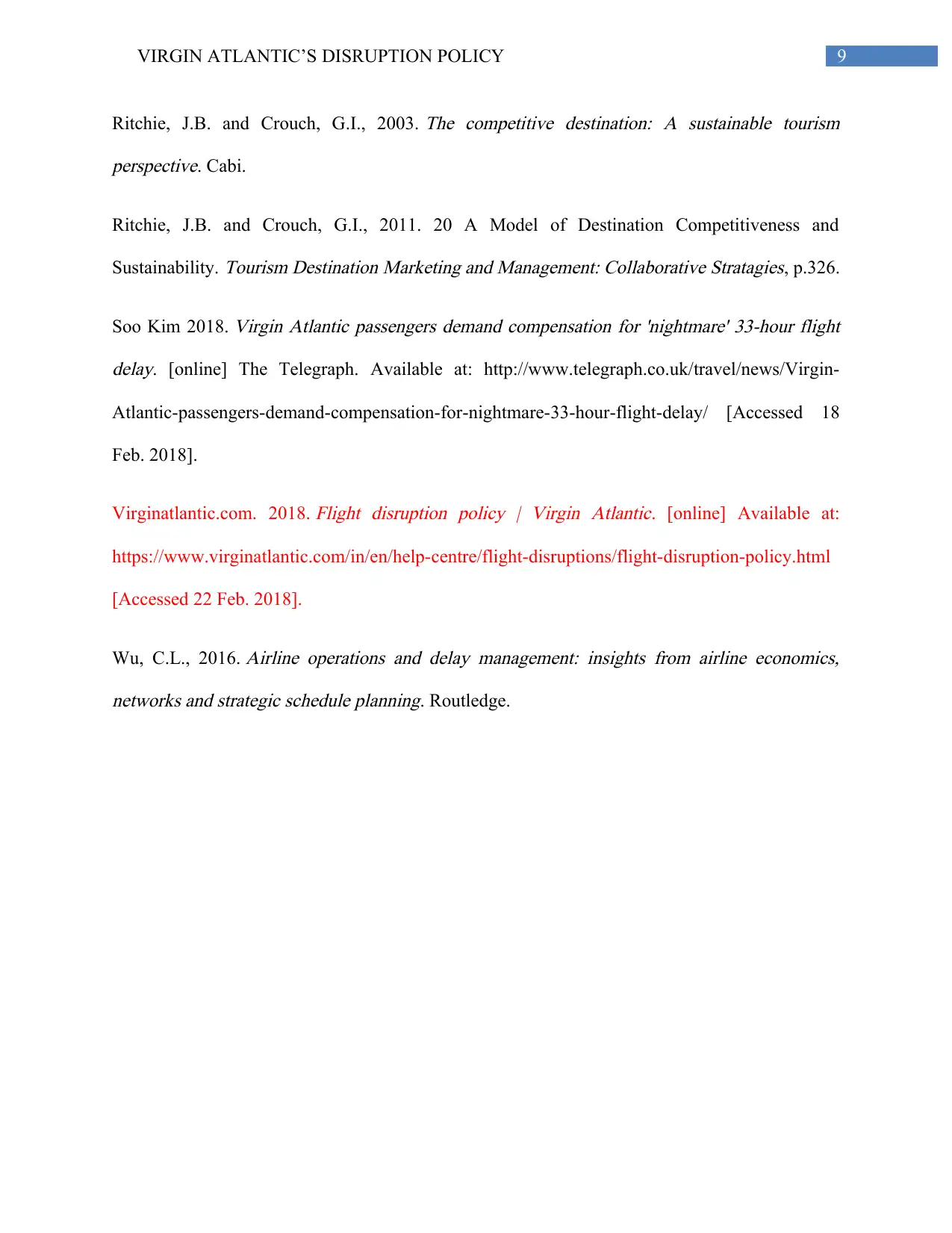
9VIRGIN ATLANTIC’S DISRUPTION POLICY
Ritchie, J.B. and Crouch, G.I., 2003.
The competitive destination: A sustainable tourism
perspective. Cabi.
Ritchie, J.B. and Crouch, G.I., 2011. 20 A Model of Destination Competitiveness and
Sustainability.
Tourism Destination Marketing and Management: Collaborative Stratagies, p.326.
Soo Kim 2018.
Virgin Atlantic passengers demand compensation for 'nightmare' 33-hour flight
delay. [online] The Telegraph. Available at: http://www.telegraph.co.uk/travel/news/Virgin-
Atlantic-passengers-demand-compensation-for-nightmare-33-hour-flight-delay/ [Accessed 18
Feb. 2018].
Virginatlantic.com. 2018.
Flight disruption policy | Virgin Atlantic. [online] Available at:
https://www.virginatlantic.com/in/en/help-centre/flight-disruptions/flight-disruption-policy.html
[Accessed 22 Feb. 2018].
Wu, C.L., 2016.
Airline operations and delay management: insights from airline economics,
networks and strategic schedule planning. Routledge.
Ritchie, J.B. and Crouch, G.I., 2003.
The competitive destination: A sustainable tourism
perspective. Cabi.
Ritchie, J.B. and Crouch, G.I., 2011. 20 A Model of Destination Competitiveness and
Sustainability.
Tourism Destination Marketing and Management: Collaborative Stratagies, p.326.
Soo Kim 2018.
Virgin Atlantic passengers demand compensation for 'nightmare' 33-hour flight
delay. [online] The Telegraph. Available at: http://www.telegraph.co.uk/travel/news/Virgin-
Atlantic-passengers-demand-compensation-for-nightmare-33-hour-flight-delay/ [Accessed 18
Feb. 2018].
Virginatlantic.com. 2018.
Flight disruption policy | Virgin Atlantic. [online] Available at:
https://www.virginatlantic.com/in/en/help-centre/flight-disruptions/flight-disruption-policy.html
[Accessed 22 Feb. 2018].
Wu, C.L., 2016.
Airline operations and delay management: insights from airline economics,
networks and strategic schedule planning. Routledge.
1 out of 10
Related Documents
Your All-in-One AI-Powered Toolkit for Academic Success.
+13062052269
info@desklib.com
Available 24*7 on WhatsApp / Email
![[object Object]](/_next/static/media/star-bottom.7253800d.svg)
Unlock your academic potential
Copyright © 2020–2025 A2Z Services. All Rights Reserved. Developed and managed by ZUCOL.





